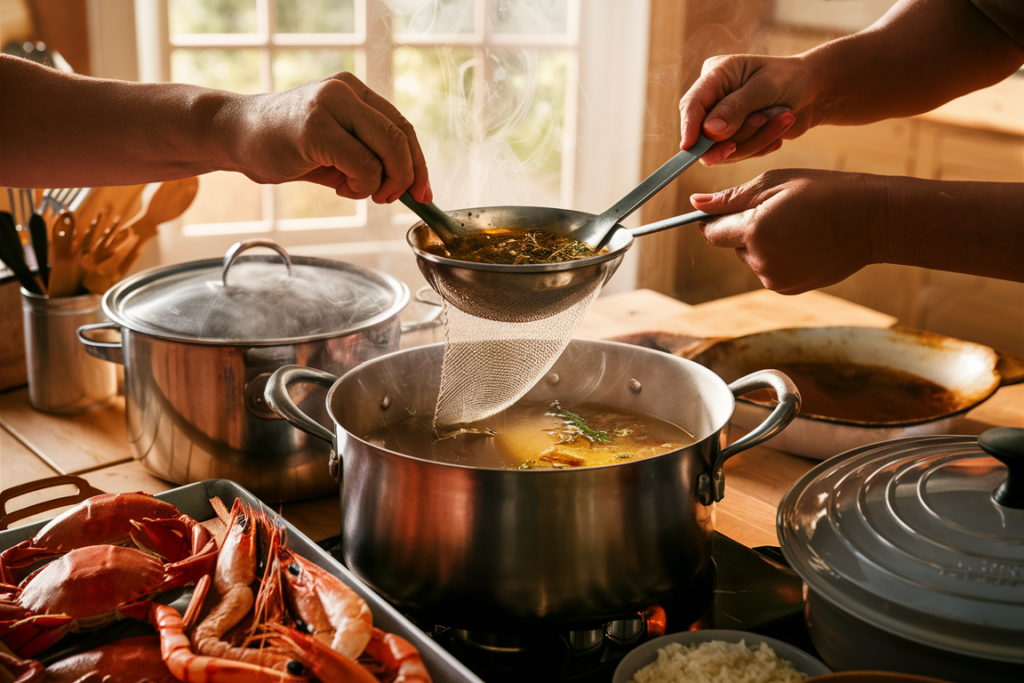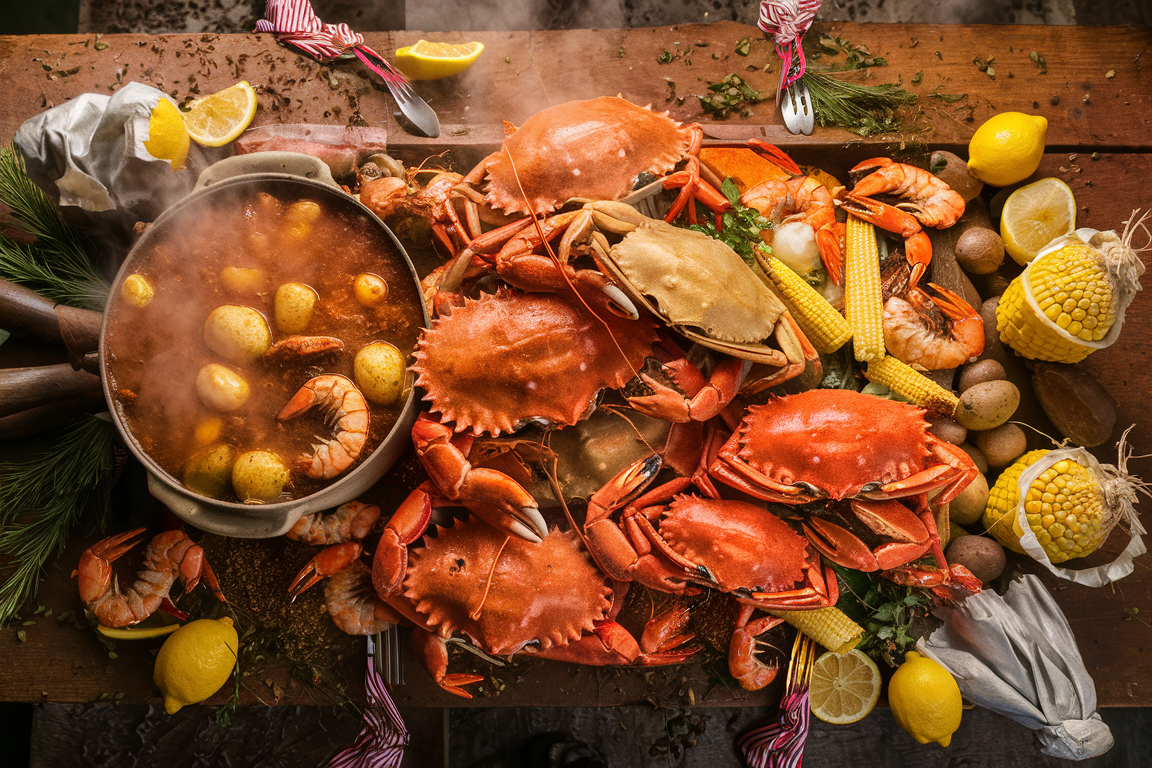Part 1: Understanding Crab Boil Liquid
What is Crab Boil Liquid?
Crab boil liquid is a flavor-infused cooking base used in preparing crabs and other seafood. This liquid is a combination of spices, aromatics, and sometimes additional flavor enhancers that impart an intense and mouth-watering taste to the seafood. The concept originated from Southern coastal cuisines and has grown in popularity across the United States and beyond.

Key features of crab boil liquid include:
- A mix of traditional and regional spices, creating a bold, aromatic flavor profile.
- The use of herbs, citrus fruits, and seasoning salts to enhance the taste.
- Flexibility, allowing cooks to tailor the liquid to their taste preferences.
Its significance goes beyond flavor—it sets the stage for a delightful culinary experience that brings families and friends together around steaming pots of delicious seafood.
Importance of Crab Boil Liquid in Seafood Cooking
The role of crab boil liquid in seafood cooking is irreplaceable. Its intense flavors are absorbed by the seafood during cooking, ensuring every bite is bursting with taste. Here’s why it’s important:
- Flavor Infusion: Ingredients like cayenne, bay leaves, and lemons infuse the seafood with deep, tangy flavors.
- Cooking Efficiency: Using a pre-seasoned liquid simplifies the preparation process and delivers consistent results.
- Cultural Heritage: Crab boils are a cornerstone of Southern culinary traditions, fostering community and celebration.
For anyone interested in experimenting with seafood, learning how to craft a crab boil liquid is a must. You can find a guide to traditional recipes that showcase the cultural richness of this cooking method.
The Role of Spices in Crab Boil Liquid
Traditional Spices Used in Crab Boils
The spices in crab boil liquid are its heart and soul. Classic ingredients include:
- Cayenne Pepper: Adds a sharp, spicy kick.
- Bay Leaves: Provide an earthy, slightly floral aroma.
- Mustard Seeds: Bring a touch of heat and a subtle tang.
- Garlic: Offers robust flavor and complements the seafood’s natural sweetness.
These ingredients not only enhance flavor but also contribute to the vibrant, festive atmosphere of a crab boil.
Regional Variations in Crab Boil Recipes
Crab boil recipes are as diverse as the regions they hail from:
- Cajun Style: Known for its spicy intensity, it often incorporates andouille sausage and corn on the cob.
- Low-Country Boil: Popular in South Carolina, it combines seafood with potatoes and sausage for a hearty feast.
- New England Style: Includes milder spices and adds clams or mussels for a seafood medley.
Exploring these variations is a great way to appreciate the versatility of crab boil liquid. Learn more about regional crab boil styles here.
Core Ingredients of Crab Boil Liquid
Essential Aromatics for Flavor Infusion
Aromatics are foundational to creating a well-rounded crab boil liquid. Essential ingredients include:
- Onions: For sweetness and depth.
- Celery: Adds a subtle bitterness that balances the richness of the seafood.
- Garlic Cloves: For bold, savory undertones.
These ingredients work together to create a complex and irresistible aroma.
Role of Citrus Elements (Lemons, Oranges)
Citrus fruits play a crucial role in crab boil liquid, contributing a fresh and tangy contrast to the rich spices.
- Lemons: Their acidity brightens the overall flavor.
- Oranges: Add a touch of sweetness that balances the heat from spices like cayenne or paprika.
Squeezing fresh lemon or orange juice into the pot just before serving can amplify these effects, enhancing the final dish.
Usage of Salt and Seasoning Mixes
Salt is indispensable in crab boil liquid—it ensures that the seafood is seasoned from the inside out. Pre-made seasoning mixes, such as Old Bay or Zatarain’s, are popular choices for:
- Convenience.
- A balanced blend of spices.
These mixes often include paprika, celery salt, and black pepper, providing a well-rounded flavor base.
Part 2: Customizing Crab Boil Liquid
Adding Complexity with Herbs
Herbs can elevate the flavor of crab boil liquid by introducing unique aromas and taste dimensions. They add a personal touch that transforms a standard recipe into something truly special.

Common Herbs Used in Crab Boil Liquid
Popular herbs used in crab boil liquids include:
- Thyme: A subtle herb that provides earthy and slightly minty undertones.
- Bay Leaves: Found in nearly every crab boil recipe for their floral and slightly bitter profile.
- Parsley: Often used as a garnish, but its stems can be added to the liquid for a fresh, peppery note.
These herbs enhance the dish without overpowering the natural flavors of the seafood.
Unique Herb Combinations for Personalized Recipes
For those looking to experiment, consider these creative combinations:
- Cilantro and Mint: Perfect for a refreshing twist with a citrus-forward crab boil.
- Basil and Oregano: Add Italian-inspired flair, complementing lighter seafood flavors.
- Tarragon and Dill: Pair beautifully with crabs for a mildly sweet and anise-like profile.
Enhancing Heat and Spice
Heat is a defining characteristic of many crab boil liquids, especially in Cajun-style recipes. It’s all about finding the right level of spice to suit your taste.
Types of Chili Peppers for Crab Boil Liquid
Different chili peppers bring unique flavors and heat levels to the boil. Some popular choices include:
- Cayenne Pepper: The classic choice for heat without overwhelming the dish.
- Jalapeños: Offer a moderate level of spiciness with a fresh, green flavor.
- Habaneros: For those who enjoy fiery, fruity heat.
- Thai Chili Peppers: Introduce an Asian twist with intense spice.
When handling hot peppers, wear gloves to avoid skin irritation. Adjust the quantity to control the heat level.
Using Hot Sauce and Chili Powder
Incorporating hot sauce and chili powder is a simple way to:
- Intensify the spice without altering the overall recipe.
- Add layers of vinegar tang (from hot sauce) and smoky depth (from chili powder).
Consider brands like Tabasco or Louisiana Hot Sauce for authenticity. Pair these with smoked paprika for a rich, smoky flavor.
Liquids for the Base
The choice of base liquid is essential in determining the final flavor profile of a crab boil. While water is the most common base, there are many options for experimenting.
Water, Stock, and Other Base Options
- Water: A neutral base that allows spices and aromatics to shine.
- Seafood Stock: Adds an extra layer of seafood richness.
- Chicken Stock: Works surprisingly well in crab boils, lending a savory undertone.
Each base has its advantages, depending on the flavor profile you’re aiming for.
Experimenting with Beer or Wine in Crab Boil Liquid
For a gourmet touch, try adding:
- Beer: Light lagers or ales bring mild bitterness and depth. Dark stouts can create a richer profile but may overpower the seafood.
- White Wine: Adds acidity and a delicate sweetness, pairing especially well with citrus elements.
When using alcohol, simmer for at least 10 minutes to cook off the raw alcohol taste while retaining its flavor-enhancing qualities.
Part 3: Advanced Techniques and Practical Tips
Preparing Crab Boil Liquid Step-by-Step
Crafting the perfect crab boil liquid is both an art and a science. A thoughtful approach ensures the seafood absorbs every ounce of flavor.

Balancing Ingredients for a Perfect Boil
A well-balanced crab boil liquid requires attention to:
- Spices: Use a mix of cayenne, paprika, and bay leaves for depth.
- Aromatics: Include garlic, onions, and celery for a savory base.
- Citrus: Lemons and oranges add brightness and counteract the richness.
- Salt and Seasoning Mixes: Adjust to taste, ensuring the liquid isn’t too salty.
Start with a ratio of 1 tablespoon of spice mix per quart of liquid. Adjust as needed, keeping the balance between heat, acidity, and salt in check.
How Long to Simmer for Maximum Flavor
Simmering time is critical for flavor infusion:
- Before Adding Seafood: Simmer the liquid for at least 15–20 minutes. This ensures the spices and aromatics fully infuse.
- After Adding Seafood: Depending on the type of seafood, cook crabs for 10–15 minutes and shrimp for just 2–3 minutes.
Avoid overcooking, as this can make seafood rubbery. Remove the pot from heat immediately after cooking and let the seafood soak for an extra 10 minutes for deeper flavor absorption.
Reusing and Storing Crab Boil Liquid
A good crab boil liquid doesn’t have to be discarded after one use. With proper handling, it can be reused or repurposed for other dishes.
Safety Tips for Reusing Boil Liquid
- Strain Immediately: Remove solids like crab shells and spices to prevent spoilage.
- Cool Quickly: Place the liquid in an ice bath to reduce its temperature rapidly.
- Store Properly: Refrigerate the strained liquid in an airtight container for up to 3 days or freeze it for longer storage.
Avoid reusing liquid if it has been sitting out for an extended period or has visible spoilage signs.
Creative Uses for Leftover Crab Boil Liquid
Leftover liquid is a treasure trove of flavor. Try using it in:
- Soups and Chowders: As a base for clam chowder or gumbo.
- Rice Dishes: Cook rice in the liquid for a seafood-inspired pilaf.
- Pasta Sauces: Reduce the liquid and combine with cream for a rich sauce.
Popular Variations and Recipes
Crab boil recipes are as diverse as their origins. Below are some popular styles to inspire your next feast.
Cajun-Style Crab Boil Liquid
- Spices: Heavy on cayenne, paprika, and mustard seeds.
- Aromatics: Garlic, onions, and celery.
- Extras: Add sausage, corn, and potatoes to the pot for a hearty meal.
This style is perfect for those who enjoy intense heat and bold flavors.
Low-Country Boil Liquid Recipe
- Spices: A mix of mild paprika and black pepper.
- Citrus: Heavy on lemons for a tangy base.
- Ingredients: Typically includes shrimp, corn, and smoked sausage.
The Low-Country boil is milder and focuses on bringing out the natural sweetness of the seafood.
Exploring Modern Fusion Takes on Crab Boil Liquid
For a contemporary twist, experiment with:
- Asian Fusion: Incorporate soy sauce, ginger, and lemongrass for a unique profile.
- Mediterranean Touch: Add oregano, thyme, and olive oil with white wine as the base.
- Caribbean Vibes: Use coconut milk, scotch bonnet peppers, and allspice.
These creative takes allow you to infuse your cultural heritage into a traditional dish.
More FAQs
- Can I use pre-made seasoning mixes for crab boil liquid?
Yes, seasoning mixes like Old Bay simplify the process and offer a well-balanced flavor. - What type of crabs work best for a crab boil?
Blue crabs and Dungeness crabs are popular choices due to their sweet and tender meat. - How much liquid do I need per pound of seafood?
Plan for at least 1 quart of liquid per pound to ensure even cooking and flavor infusion. - What is the best way to prevent overcooking seafood?
Remove seafood as soon as it turns opaque and firm, and allow it to soak in the hot liquid off the heat. - Can I make crab boil liquid vegetarian?
Absolutely. Use vegetable stock as the base and omit seafood. - How do I adjust the heat level for guests who don’t like spice?
Reduce cayenne and hot peppers, and serve hot sauce on the side. - Can I use frozen seafood for a crab boil?
Yes, but thaw the seafood completely to ensure even cooking. - What sides pair well with a crab boil?
Cornbread, coleslaw, and potato salad are excellent options. - How long can I store leftover crab boil liquid in the freezer?
Frozen liquid can last up to 3 months if stored properly. - Can I add other proteins like chicken or sausage?
Yes, andouille sausage is a classic addition, while chicken works well in fusion variations.

